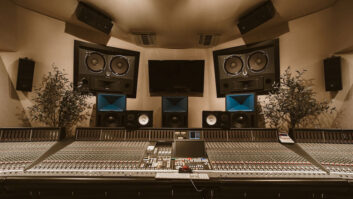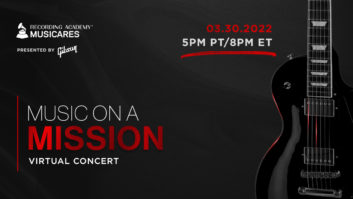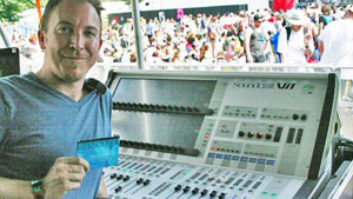
For Fitz and the Tantrums’ self-titled third album, Michael “Fitz” Fitzpatrick’s songwriting and recording experience was nothing like the Los Angeles group’s first two full-lengths. The recording processes were very different from each other the first two times around, but the songwriting, albeit with contrasting central instruments, was not that far removed from one to the next. Fitzpatrick expected more or less the same experience for Fitz and the Tantrums, but was instead met with a series of failed attempts.
“We got off of however many years of touring after Pickin’ Up the Pieces, took literally one day off and started recording More Than Just A Dream,” says Fitzpatrick, sitting in his expansive home studio, which has the luxury of not only housing his famed Conn organ and his upright piano, but also myriad synthesizers, outboard compressors and EQs, as well as drum machines and, of course, his computer; there’s also a comfortable sectional sofa.
“We had this crazy output where we did 35 songs in 40 days, went into a week of pre-production, then in with Tony Hoffer for three weeks and the album was done,” he recalls. “Then we were on the road for three years. I had to have vocal surgery because of polyps I had developed from crazy overuse. When I healed from that, I thought, ‘We’ll just do what we did last time.’ But it was a lot harder. I had a clearer sense of what progression was going to look like from album one to album two. On album three, I didn’t know what that was going to be. I just knew my end goal is always to be evolving.”
Songwriter Sam Hollander (Panic! at the Disco, Katy Perry, Pentatonix) proved to be Fitzpatrick’s musical soulmate. At Hollander’s home studio, not a huge leap from Fitzpatrick’s setup, Hollander and his assistant, Grant Michaels, provided Fitzpatrick with a fresh space and a new batch of sounds. They meshed well with his, to quote, “frenetic, sloppy, and raw” style of working, and in the process, got his confidence back.
The first song they successfully completed is the sticky single and album opener, “Handclap,” which signals yet another change in direction for the band. With each album, the six-piece jumps forward 30 years in musical time. The ’50s Motown-inspired sound of their debut morphed into the ’80s R&B flavor of its successor, and now, Fitz and the Tantrums shifts into the present with a sound that is very characteristic of today—albeit, with nods to the past. Bright vocals and modern phrasing lead the songs that feature as much studio-generated sounds as they do live instruments. The album reaches as far as the reggae vibes of “Roll Up,” the energizing classic Hall and Oates-influenced “Get Right Back,” and the stuttering “Burn It Down,” which is equal parts pop and ballad.

Producer Jesse Shaktin. Photo: Lindsey Byrnes
Instead of an organic instrument, which drove the first two albums, it’s programmed beats that provide both the starting point and direction of Fitz and the Tantrums. Fitzpatrick flips between Native Instruments Maschine and XLN Audio Addictive Drums 2. The former has similar functionality (with infinitely more sounds) to an MPC, which Fitzpatrick had become comfortable with over the years, while the latter has every kind of drum kit and drum machine recorded in the best drum room possible onto 2-inch tape with near- and far-field miking. This is a dream for Fitzpatrick who is all about mixing an 808 drum kick, for instance, with a dry ’60s snare to create what he calls “a weird Frankenstein drum sound.” The group’s drummer, John Wicks, is also a fan of programmed drums and works with the medium that best serves the song.
The group spent some days recording drums and bass at Sunset Sound’s Studio A, where the custom API console was a huge attraction. Engineer Darrell Thorp had a Neumann U 47 FET on the kick, adding a Yamaha NS10 monitor to create a subkick. Shure SM57s are on the top and bottom of the snare, with Neumann KM 54 on the hi-hat, and AKG C414s on the tom and on the floor. Overhead is a mono U 47 FET with 1176 on the insert, and Royer R-121 ribbons on the hi-hat and floor.
To keep the process fresh, Fitzpatrick employs new plug-ins, particular favorites being the Valhalla for its lengthy reverbs, VPS Phalanx for its modification capabilities, and Chris Lord-Alge’s vocal one for its speediness. Says Fitz, “Prior to this record, I would always open up a vocal chain, put a limiter, a compressor, an EQ, reverb, delay. CLA has all those within one plug-in. I adjust the levels and it became a huge part of what my vocal sounds like on this record, where there are a lot of top frequencies coming through. We went for a much more brilliant vocal treatment than in the past. CLA was an immediate, creative tool with an incredibly present sound and I wouldn’t have to work for it.”
For Noelle Scaggs’ vocals, Fitzpatrick uses a chain unique to her, particularly in terms of the compression rate and EQ. Additionally, Tony Maserati Waves plug-ins are used for Scaggs as they sit better with her vocals. Both Scaggs’ and Fitzpatrick’s vocals are recorded at his home studio, where he now has a new Neumann U 87 Ai Shockmount Set Z microphone with box and a full rack that includes a Teletronix tube compressor and BAE 1073 DMP single-channel EQ. Sessions are kept in MIDI for as long as possible. This way Fitzpatrick can change tempos and keys repeatedly until he finds the perfect place where his and Scaggs’ voices work best. When not in MIDI, the entire song had to be rerecorded, which on “A Place For Us,” happened three different times.
“I tried to use my voice as another instrument, chopped in Pro Tools and then pitch-shifted to sound robotic and weird,” Fitzpatrick says. “Or I would record my voice doing a ‘bomp,’ load it into Phalanx and play it as a keyboard sound. It has its own reverb, compressor, delay and limiter inside, plus a lot of amazing presets. To create some really unique keyboard sounds for this record, I chop my vocal, sample that, then play it and run it through a bunch of internal effects, then add another compressor or delay on top of it. That way I have a signature sound that nobody else has.”
This key element is one of the reasons Jesse Shaktin (Sia, Charlie Puth) is producer of eight of the 11 songs on Fitz and the Tantrums. Shaktin, who has been collecting sounds since his teens, has a library that appears unrivaled. This is developed with Phalanx, Logic EXS24 and iZotope Iris, as well as Spectrasonics Omnisphere, Native Instruments Massive, LennarDigital Sylenth, and NI Reaktor blocks. With what Fitzpatrick brought to him, Shaktin did layering of more sounds. Says Fitzpatrick, “On some songs the verse has four snares, two handclaps, three finger snaps, all blended, where we’ve changed the levels to find this truly unique sound for the backbeat.”
“For me, one way to make programmed drums not feel boring and repetitive is to add texture,” says Shaktin, also from a home studio similar to Fitzpatrick’s and Hollander’s. “There is the main snare made by two different snares [or three or four]. There is a subtle layer than happens on the second, or every eighth hit, to have emphasis and texture here and there. Some of them are reverb tail ambient textures, some of them are driving—to keep the soundscape moving. Oftentimes, it’s a few different types of textures that go on the backbeat. On an instrumental part, that could be a line from a Sylenth patch, but if that is not appropriate for a guitar or a horn, we layer it with something more pluck-y. If it’s not the right thing, we can add and subtract different textures and sounds. It’s a few layers, but it sounds like one part.”





